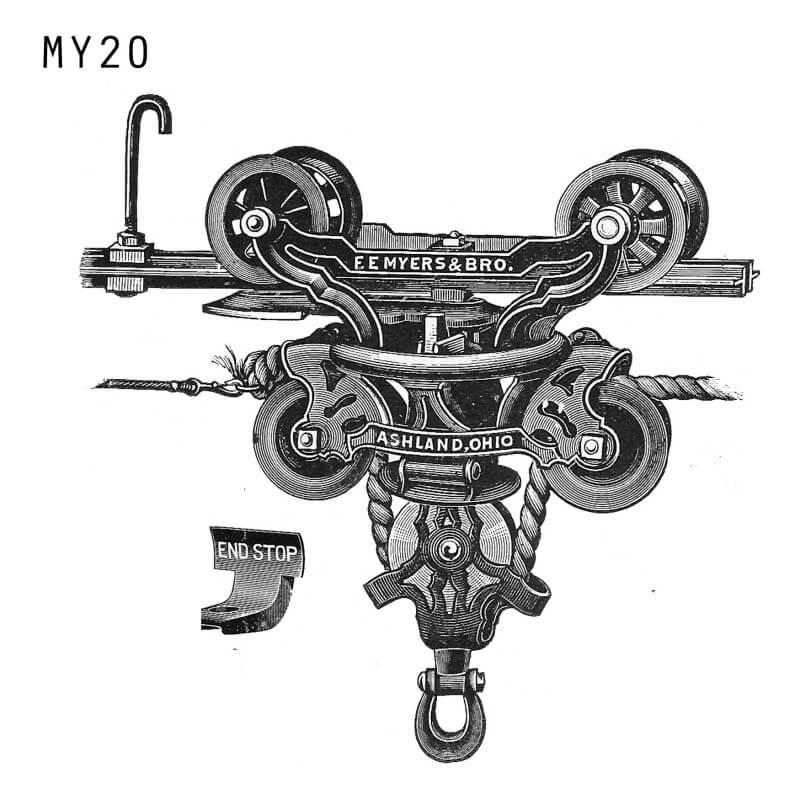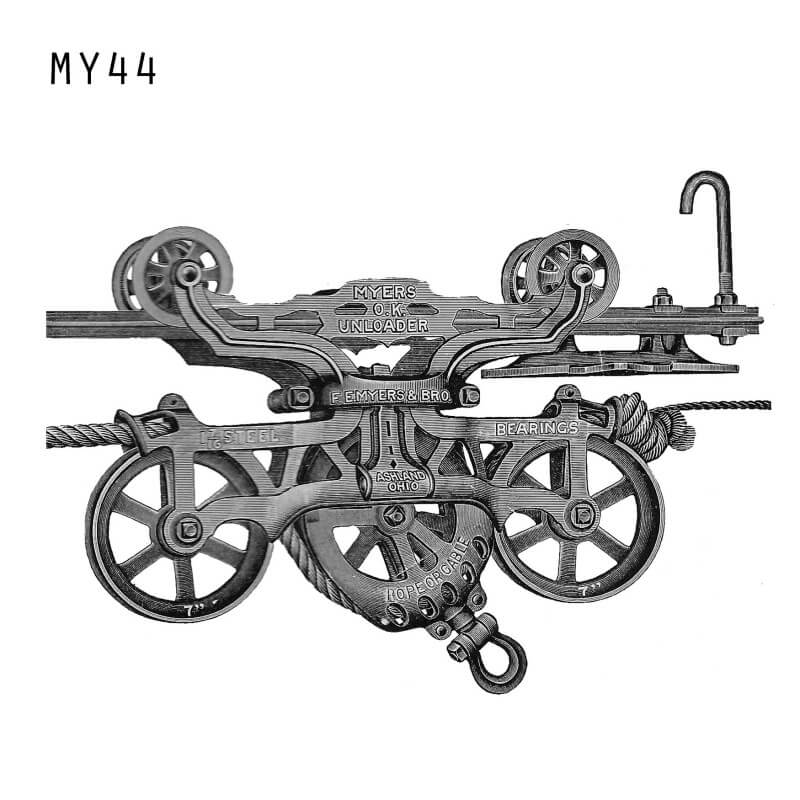
Headquarters:
Ashland, OhioAlso sold under the names (if applicable): Ashland, Clover Leaf, Cross Draft, Haymaker, Imperial, JC, OK, Rundle, Sure-Lock, and XX
History:
Francis E. Myers (1849 – 1923) Phillip Myers (1853-1932)
In 1815, Uniontown, Ohio, was little more than a frontier outpost. Less than 100 years later, the town had been renamed Ashland, and boasted 47 factories and a population of 8,000. As an early manufacturing center, Ashland was home to Reliable Match C o. (“Strike Anywhere Matches”), Kauffman Mfg. Co. (manufacturer of folding chairs used in Union Army encampments), Dr. Hess & Clark (veterinary supplies and disinfectants) and T.W. Miller’s Faultless Rubber Co. (rubber sundries, surgical goods and bicycle tires).
o. (“Strike Anywhere Matches”), Kauffman Mfg. Co. (manufacturer of folding chairs used in Union Army encampments), Dr. Hess & Clark (veterinary supplies and disinfectants) and T.W. Miller’s Faultless Rubber Co. (rubber sundries, surgical goods and bicycle tires).
 But Ashland’s biggest manufacturer in 1915 was F.E. Myers & Bro., a manufacturer of water pumps and hay tools who employed a workforce of nearly 800. Brothers Francis E. Myers and Philip A. Myers grew up on a farm just outside of Ashland within earshot of their neighbors, the Studebakers … yes, those Studebakers. That clan initially manufactured wagons, but left the area in the mid-1800s for South Bend, Ind., where they became automakers. F.E. Myers got his start as a salesman of farm equipment and cider presses for the Ashland Machine Co. When that company went bankrupt, Myers represented Bucher & Gibbs Co. and the Imperial Plow Co., both of Canton, Ohio. At about the same time, in 1870, F.E. Myers went into business for himself and persuaded his brother Philip to join him. The pair first operated a repair shop and sold farm equipment.Every farm family needed water, and F.E. Myers saw an opportunity to build pumps to meet that need. Philip was captivated by the mechanics of the water pump. He secured a patent for a double-action pump that delivered water in a steady stream rather than spurts. Two years later he designed a pump with a unique glass valve seat that would neither corrode nor leak. Howard E. Covington Jr. in Living the American Dream: The Myers and Miller Families of Ashland, Ohio notes that, unable to copy P.A. Myers’ patented glass valve, which increased the life and force of the pump, competitors were forced to buy valves from Myers. The brothers were a complementary pair and worked well together. Francis E. Myers was a superior salesman, promoter and businessman. Philip, widely considered a mechanical genius, liked to design and invent. Eventually, two other Myers brothers (Alvah N. and G. Denton) joined the firm.
But Ashland’s biggest manufacturer in 1915 was F.E. Myers & Bro., a manufacturer of water pumps and hay tools who employed a workforce of nearly 800. Brothers Francis E. Myers and Philip A. Myers grew up on a farm just outside of Ashland within earshot of their neighbors, the Studebakers … yes, those Studebakers. That clan initially manufactured wagons, but left the area in the mid-1800s for South Bend, Ind., where they became automakers. F.E. Myers got his start as a salesman of farm equipment and cider presses for the Ashland Machine Co. When that company went bankrupt, Myers represented Bucher & Gibbs Co. and the Imperial Plow Co., both of Canton, Ohio. At about the same time, in 1870, F.E. Myers went into business for himself and persuaded his brother Philip to join him. The pair first operated a repair shop and sold farm equipment.Every farm family needed water, and F.E. Myers saw an opportunity to build pumps to meet that need. Philip was captivated by the mechanics of the water pump. He secured a patent for a double-action pump that delivered water in a steady stream rather than spurts. Two years later he designed a pump with a unique glass valve seat that would neither corrode nor leak. Howard E. Covington Jr. in Living the American Dream: The Myers and Miller Families of Ashland, Ohio notes that, unable to copy P.A. Myers’ patented glass valve, which increased the life and force of the pump, competitors were forced to buy valves from Myers. The brothers were a complementary pair and worked well together. Francis E. Myers was a superior salesman, promoter and businessman. Philip, widely considered a mechanical genius, liked to design and invent. Eventually, two other Myers brothers (Alvah N. and G. Denton) joined the firm.
 In 1882, the Myers brothers exhibited their pumps at the Ohio State Fair, winning the highest award for the best pumps. Two years later, Philip won a patent for a hay carrier, which evolved into a lucrative line of Myers hay tools. In 1910 he invented a sprayer used to kill mosquitoes in the Panama Canal Zone, protecting thousands of workers from insect-borne malaria. A year later, company officials boasted an international network of 30,000 dealers engaged in the sale of Myers pumps. Meanwhile, Myers had grown into one of the largest manufacturers of barn track and hay carriers.By 1896, F.E. Myers was recognized as Ashland’s leading citizen, known as a strongly principled and benevolent man and progressive employer. As early as 1916, for instance, F.E. Myers & Bro. introduced life and medical insurance coverage for all Myers employees.F.E. Myers played a highly visible role in the community. He financed the rail line connecting Ashland and Cleveland, chaired the Ohio State Commission at the Panama Pacific Exposition in San Francisco and was president of one bank and director of another. He was a trustee of Wittenberg College and director of the local YMCA, and built an imposing stone mansion just south of Main Street. He also owned the largest producing gas well in the area, which supplied gas to his factories. The company’s products enjoyed tremendous success. In 1892 Myers produced 9,000 pulleys for its hay tool line. Ten years later, production of the same pulley topped the 260,000 mark. “At the time, the company was overwhelmed with business,” Covington writes. He referenced a piece of 1902 correspondence reporting that “Orders for tank pumps, spray pumps, power pumps and tandem hangers are coming faster than they can fill them …” The company’s annual catalog, an inch-thick book, detailed an extensive line of products.
In 1882, the Myers brothers exhibited their pumps at the Ohio State Fair, winning the highest award for the best pumps. Two years later, Philip won a patent for a hay carrier, which evolved into a lucrative line of Myers hay tools. In 1910 he invented a sprayer used to kill mosquitoes in the Panama Canal Zone, protecting thousands of workers from insect-borne malaria. A year later, company officials boasted an international network of 30,000 dealers engaged in the sale of Myers pumps. Meanwhile, Myers had grown into one of the largest manufacturers of barn track and hay carriers.By 1896, F.E. Myers was recognized as Ashland’s leading citizen, known as a strongly principled and benevolent man and progressive employer. As early as 1916, for instance, F.E. Myers & Bro. introduced life and medical insurance coverage for all Myers employees.F.E. Myers played a highly visible role in the community. He financed the rail line connecting Ashland and Cleveland, chaired the Ohio State Commission at the Panama Pacific Exposition in San Francisco and was president of one bank and director of another. He was a trustee of Wittenberg College and director of the local YMCA, and built an imposing stone mansion just south of Main Street. He also owned the largest producing gas well in the area, which supplied gas to his factories. The company’s products enjoyed tremendous success. In 1892 Myers produced 9,000 pulleys for its hay tool line. Ten years later, production of the same pulley topped the 260,000 mark. “At the time, the company was overwhelmed with business,” Covington writes. He referenced a piece of 1902 correspondence reporting that “Orders for tank pumps, spray pumps, power pumps and tandem hangers are coming faster than they can fill them …” The company’s annual catalog, an inch-thick book, detailed an extensive line of products.
When F.E. Myers & Bro. incorporated in 1921, the company was valued at $6 million. Two years later, F.E. Myers died at age 76. P.A. Myers then took the helm. The company continued to thrive, and by 1929 Myers factories and foundries (some still standing today) covered 12 acres in Ashland. Despite challenges both internal (P.A. Myers’ 1932 death from injuries sustained in an automobile accident) and external (the 1929 stock market crash and Great Depression), the family-led company remained in business throughout the 1930s and beyond. In 1949 the Myers workforce numbered more than 1,100.Change, though, was in the wind. In post-World War II years, rural electrification eliminated the need for home water pumps. At the same time, the advance of mechanization reduced the need for many of the hay tools designed by P.A. Myers. At that point, Myers became more involved in more efficient pumps and water filtration and softening systems.In 1960, the company was sold to McNeil Machine & Engineering Co., Akron, Ohio. Pentair Inc., St. Paul, Minn., purchased McNeil in 1986. Pentair continues in operation as a manufacturer of pumps, with facilities in Sacramento, Calif.; Jacksonville, Fla.; Kitchener, Ontario, Canada; and Midland, Texas (operating as Aplex Industries).
 For more information:
For more information:
– The Ashland County Historical Society, (419) 289-3111. The historical society’s museums house an extensive collection of Myers products and memorabilia. – Living the American Dream: The Myers and Miller Families of Ashland, Ohio, by Howard E. Covington Jr., available through Ashland County Historical Society.
THIS PAGE IS DEDICATED TO THE MEMORY OF GEORGE FOGLE. George for all intents and purposes was one of the first hay trolley collectors. George was an attendee at most of the hay trolley shows and a great inspiration as well as an encyclopedia of hay trolley knowledge. George’s favorite trolley manufacturer was F.E. Myers.
































































